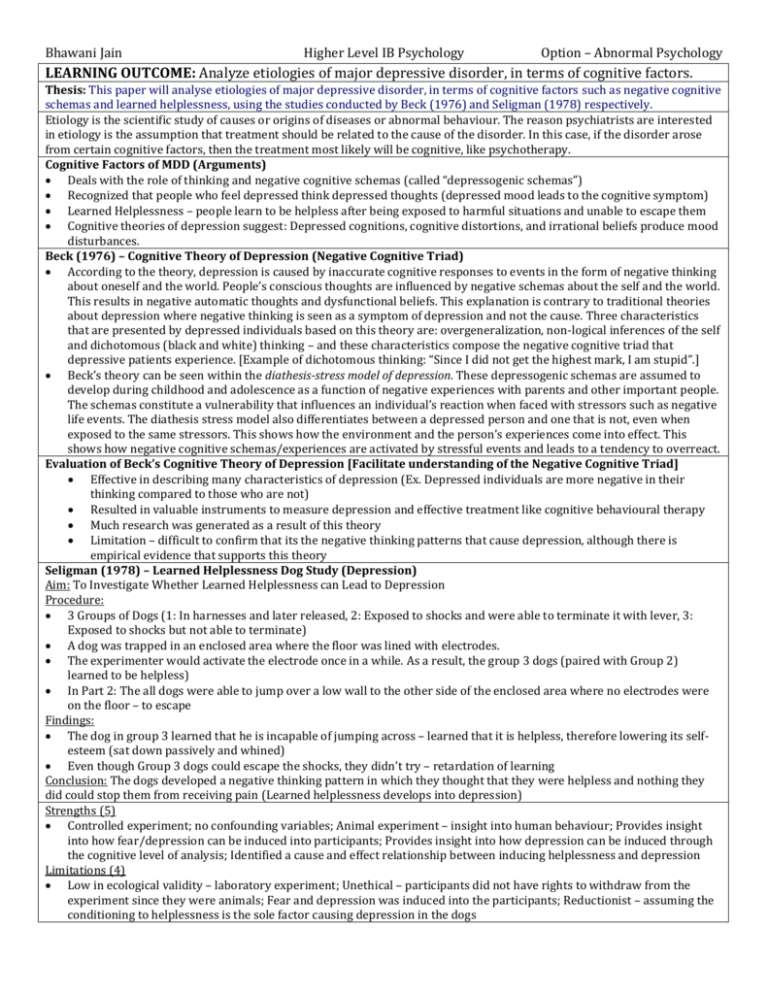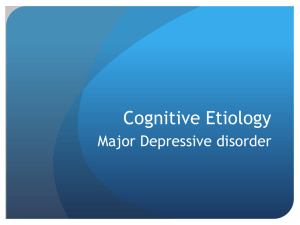File - IB Psychology Mr Poll
advertisement

Bhawani Jain Higher Level IB Psychology Option – Abnormal Psychology LEARNING OUTCOME: Analyze etiologies of major depressive disorder, in terms of cognitive factors. Thesis: This paper will analyse etiologies of major depressive disorder, in terms of cognitive factors such as negative cognitive schemas and learned helplessness, using the studies conducted by Beck (1976) and Seligman (1978) respectively. Etiology is the scientific study of causes or origins of diseases or abnormal behaviour. The reason psychiatrists are interested in etiology is the assumption that treatment should be related to the cause of the disorder. In this case, if the disorder arose from certain cognitive factors, then the treatment most likely will be cognitive, like psychotherapy. Cognitive Factors of MDD (Arguments) Deals with the role of thinking and negative cognitive schemas (called “depressogenic schemas”) Recognized that people who feel depressed think depressed thoughts (depressed mood leads to the cognitive symptom) Learned Helplessness – people learn to be helpless after being exposed to harmful situations and unable to escape them Cognitive theories of depression suggest: Depressed cognitions, cognitive distortions, and irrational beliefs produce mood disturbances. Beck (1976) – Cognitive Theory of Depression (Negative Cognitive Triad) According to the theory, depression is caused by inaccurate cognitive responses to events in the form of negative thinking about oneself and the world. People’s conscious thoughts are influenced by negative schemas about the self and the world. This results in negative automatic thoughts and dysfunctional beliefs. This explanation is contrary to traditional theories about depression where negative thinking is seen as a symptom of depression and not the cause. Three characteristics that are presented by depressed individuals based on this theory are: overgeneralization, non-logical inferences of the self and dichotomous (black and white) thinking – and these characteristics compose the negative cognitive triad that depressive patients experience. [Example of dichotomous thinking: “Since I did not get the highest mark, I am stupid”.] Beck’s theory can be seen within the diathesis-stress model of depression. These depressogenic schemas are assumed to develop during childhood and adolescence as a function of negative experiences with parents and other important people. The schemas constitute a vulnerability that influences an individual’s reaction when faced with stressors such as negative life events. The diathesis stress model also differentiates between a depressed person and one that is not, even when exposed to the same stressors. This shows how the environment and the person’s experiences come into effect. This shows how negative cognitive schemas/experiences are activated by stressful events and leads to a tendency to overreact. Evaluation of Beck’s Cognitive Theory of Depression [Facilitate understanding of the Negative Cognitive Triad] Effective in describing many characteristics of depression (Ex. Depressed individuals are more negative in their thinking compared to those who are not) Resulted in valuable instruments to measure depression and effective treatment like cognitive behavioural therapy Much research was generated as a result of this theory Limitation – difficult to confirm that its the negative thinking patterns that cause depression, although there is empirical evidence that supports this theory Seligman (1978) – Learned Helplessness Dog Study (Depression) Aim: To Investigate Whether Learned Helplessness can Lead to Depression Procedure: 3 Groups of Dogs (1: In harnesses and later released, 2: Exposed to shocks and were able to terminate it with lever, 3: Exposed to shocks but not able to terminate) A dog was trapped in an enclosed area where the floor was lined with electrodes. The experimenter would activate the electrode once in a while. As a result, the group 3 dogs (paired with Group 2) learned to be helpless) In Part 2: The all dogs were able to jump over a low wall to the other side of the enclosed area where no electrodes were on the floor – to escape Findings: The dog in group 3 learned that he is incapable of jumping across – learned that it is helpless, therefore lowering its selfesteem (sat down passively and whined) Even though Group 3 dogs could escape the shocks, they didn’t try – retardation of learning Conclusion: The dogs developed a negative thinking pattern in which they thought that they were helpless and nothing they did could stop them from receiving pain (Learned helplessness develops into depression) Strengths (5) Controlled experiment; no confounding variables; Animal experiment – insight into human behaviour; Provides insight into how fear/depression can be induced into participants; Provides insight into how depression can be induced through the cognitive level of analysis; Identified a cause and effect relationship between inducing helplessness and depression Limitations (4) Low in ecological validity – laboratory experiment; Unethical – participants did not have rights to withdraw from the experiment since they were animals; Fear and depression was induced into the participants; Reductionist – assuming the conditioning to helplessness is the sole factor causing depression in the dogs





